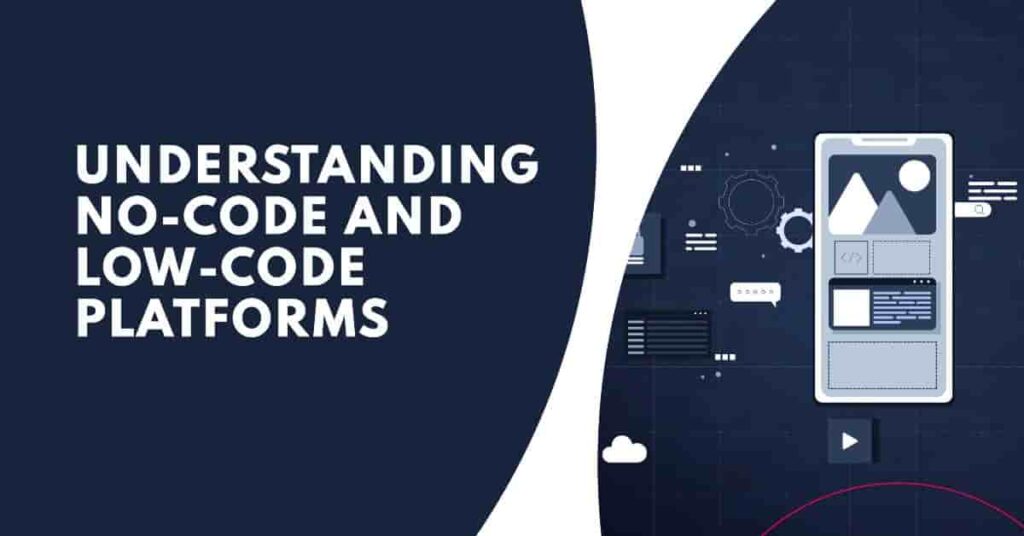Understanding No-Code and Low-Code Platforms
In today’s digital world, new tools like no-code and low-code platforms are changing how software is developed. These tools are making it easier for a wider range of people to create software, which is especially important for places like Africa where it can help businesses succeed and economies grow. Valdymas Africa is a great example of a company using these tools to support local businesses and improve efficiency, leading to economic progress.

No-Code Platforms
No-code platforms enable users to create applications through graphical user interfaces (GUIs) and pre-built modules without any coding. Examples include WordPress for website creation, Webflow for web design, and Airtable for database management. These tools are designed for ease of use, employing drag-and-drop functionalities that make app development intuitive.
Low-Code Platforms
Low-code platforms, while also simplifying the development process, require some coding knowledge. They offer pre-built components and templates that users can customize with minimal coding. Platforms such as Microsoft PowerApps, OutSystems, and Mendix balance ease of use with the flexibility needed for more complex projects.
Valdymas Africa: A Hub for No-Code and Low-Code Innovation
Valdymas Africa is a leading technology hub in Africa, leveraging no-code and low-code platforms to drive business intelligence and innovation across the continent. By offering training and resources, Valdymas Africa empowers local entrepreneurs and businesses to create custom applications, streamline operations, and enhance productivity.
The Evolution of Business Intelligence through No-Code Platforms
WordPress: WordPress is a prime example of how no-code platforms revolutionize web development. Initially launched as a blogging tool, WordPress has evolved into a powerful content management system (CMS) that powers over 40% of all websites globally. Valdymas Africa utilizes WordPress to help businesses establish an online presence quickly and efficiently. With its extensive library of plugins and themes, users can create highly customized websites without writing a single line of code. This accessibility allows businesses to quickly establish an online presence, conduct e-commerce, and manage digital content efficiently.
Webflow: Webflow takes web design a step further by combining the ease of drag-and-drop interfaces with the power of advanced design capabilities. It allows designers to create visually stunning websites with professional-grade animations and interactions without any coding. For business intelligence, WebFlow provides seamless integration with various analytics and marketing tools, enabling businesses to track user behavior, optimize SEO, and enhance user experience.
Airtable: Airtable bridges the gap between spreadsheets and databases, offering a no-code solution for managing and organizing information. It provides a versatile platform where users can create custom applications for project management, CRM, and more. By integrating with various third-party tools and services, Airtable enables businesses to automate workflows, improve data accuracy, and gain insights from their data without needing extensive technical expertise.
Enhancing Business Intelligence with Low-Code Platforms
Microsoft PowerApps: PowerApps is a robust low-code platform that enables users to build custom business applications. It integrates seamlessly with other Microsoft services like Office 365, Dynamics 365, and Azure, making it a powerful tool for enhancing business intelligence.Valdymas Africa utilizes PowerApps to develop applications that automate processes, collect and analyze data, and provide real-time insights. With PowerApps, businesses can create applications that automate processes, collect and analyze data, and provide real-time insights, all while reducing development time and costs.
OutSystems: OutSystems is known for its scalability and flexibility, allowing businesses to create complex applications with minimal coding. It supports a wide range of use cases, from customer-facing applications to internal business tools. OutSystems offers built-in analytics and reporting capabilities, enabling businesses to monitor application performance and make data-driven decisions. Its integration capabilities with existing systems ensure that businesses can leverage their current IT investments while innovating.
Mendix: Mendix is a low-code platform that emphasizes speed and collaboration. It allows business users and developers to work together in creating applications that address specific business needs. Mendix’s robust analytics and reporting tools help businesses gain insights from their data, improve operational efficiency, and drive innovation. Its cloud-native architecture ensures scalability and flexibility, supporting businesses as they grow and evolve.
Impact of No-Code and Low-Code Platforms on Business Intelligence
The impact of no-code and low-code platforms on business intelligence is profound. These platforms enable businesses to harness the power of data and technology without the need for extensive IT resources. Here are some key ways they have transformed business intelligence:
Accelerated Development Cycles: Traditional software development is often time-consuming and resource-intensive. No-code and low-code platforms significantly reduce development time, allowing businesses to deploy applications quickly. This acceleration is crucial in today’s fast-paced market, where timely responses to market changes and customer needs are critical.
Cost Efficiency: Developing applications using traditional methods can be expensive, requiring skilled developers and extensive testing. No-code and low-code platforms lower development costs by enabling non-technical users to create applications and by reducing the need for large development teams. This cost efficiency allows businesses to allocate resources to other strategic areas.
Empowerment of Non-Technical Users: Also known as “citizen developers,” non-technical users can now contribute to the development process. This democratization fosters a culture of innovation, as those closest to business challenges can create tailored solutions. It also reduces the bottleneck on IT departments, allowing them to focus on more complex tasks.
Enhanced Collaboration: No-code and low-code platforms facilitate collaboration between business users and IT teams. By providing a common platform where both parties can work together, these tools ensure that applications align with business objectives and technical standards. This collaboration results in more effective and user-centric solutions.
Scalability and Flexibility: These platforms are designed to scale with the business. Whether starting with a simple application or expanding to complex, enterprise-wide solutions, no-code and low-code platforms offer the flexibility needed to grow and adapt. This scalability ensures that businesses can continue to innovate without being constrained by their development tools
Integration Capabilities: Integration is a critical aspect of modern business intelligence. No-code and low-code platforms often come with built-in integration features, allowing seamless connectivity with other software and services. This capability ensures that new applications can easily fit into existing tech ecosystems, providing a holistic view of business operations.
The Future of No-Code and Low-Code Development in Africa
The future of no-code and low-code development in Africa looks promising, with Valdymas Africa leading the charge. As technology continues to evolve, these platforms are expected to become even more powerful, offering greater capabilities and bridging the gap between technical and non-technical users. They are set to play a pivotal role in the digital transformation journey of many African businesses, fostering a culture of innovation and agility.
Valdymas Africa’s Role in Training and Development
To maximize the impact of no-code and low-code platforms, Valdymas Africa invests in extensive training programs. These programs aim to equip local entrepreneurs and business professionals with the skills needed to leverage these platforms effectively. By fostering a community of skilled users, Valdymas Africa ensures that the benefits of these technologies are widely spread, contributing to the continent’s overall economic growth.
Conclusion
The rise of no-code and low-code development platforms has revolutionized the way businesses approach software development, making it more accessible and cost-effective. Valdymas Africa stands at the forefront of this transformation, leveraging these platforms to empower businesses, enhance operational efficiency, and drive innovation. By providing training, resources, and support, Valdymas Africa ensures that the benefits of these technologies are realized across the continent, fostering a culture of innovation and contributing to economic growth. In a world where technology is a key driver of success, the role of no-code and low-code platforms in empowering business intelligence and innovation cannot be overstated.
Reference
Radigan, Dan. “No-code and Low-code Development Platforms: The Future of App Development.” https://www.atlassian.com/agile/software-development/no-code-low-code.



